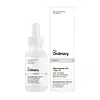What's inside
What's inside
 Key Ingredients
Key Ingredients

 Benefits
Benefits

 Concerns
Concerns

 Ingredients Side-by-side
Ingredients Side-by-side

Water
Skin ConditioningCetearyl Ethylhexanoate
EmollientCaprylic/Capric Triglyceride
MaskingTriisononanoin
Skin ConditioningPentylene Glycol
Skin ConditioningAmmonium Acryloyldimethyltaurate/Carboxyethyl Acrylate Crosspolymer
Cetearyl Alcohol
EmollientPrunus Amygdalus Dulcis Oil
Skin ConditioningPrunus Amygdalus Dulcis Fruit Extract
Skin ConditioningVanilla Planifolia Fruit Extract
Skin ConditioningGlyceryl Distearate
EmollientAvena Sativa Kernel Protein
Skin ConditioningLactic Acid
BufferingMandelic Acid
AntimicrobialPanthenol
Skin ConditioningGlyceryl Stearate
EmollientSodium Levulinate
Skin ConditioningSodium Phytate
Tocopherol
AntioxidantIsopropyl Myristate
EmollientCeteareth-20
CleansingXanthan Gum
EmulsifyingPolyglyceryl-3 Diisostearate
EmulsifyingLecithin
EmollientGlycerin
HumectantGlyceryl Caprylate
EmollientLevulinic Acid
PerfumingPotassium Sorbate
Preservative1,2-Hexanediol
Skin ConditioningCaprylyl Glycol
EmollientTetrasodium EDTA
Sodium Hydroxide
BufferingCinnamic Acid
PerfumingWater, Cetearyl Ethylhexanoate, Caprylic/Capric Triglyceride, Triisononanoin, Pentylene Glycol, Ammonium Acryloyldimethyltaurate/Carboxyethyl Acrylate Crosspolymer, Cetearyl Alcohol, Prunus Amygdalus Dulcis Oil, Prunus Amygdalus Dulcis Fruit Extract, Vanilla Planifolia Fruit Extract, Glyceryl Distearate, Avena Sativa Kernel Protein, Lactic Acid, Mandelic Acid, Panthenol, Glyceryl Stearate, Sodium Levulinate, Sodium Phytate, Tocopherol, Isopropyl Myristate, Ceteareth-20, Xanthan Gum, Polyglyceryl-3 Diisostearate, Lecithin, Glycerin, Glyceryl Caprylate, Levulinic Acid, Potassium Sorbate, 1,2-Hexanediol, Caprylyl Glycol, Tetrasodium EDTA, Sodium Hydroxide, Cinnamic Acid
 Reviews
Reviews

Ingredients Explained
These ingredients are found in both products.
Ingredients higher up in an ingredient list are typically present in a larger amount.
Pentylene glycol is typically used within a product to thicken it. It also adds a smooth, soft, and moisturizing feel to the product. It is naturally found in plants such as sugar beets.
The hydrophilic trait of Pentylene Glycol makes it a humectant. As a humectant, Pentylene Glycol helps draw moisture from the air to your skin. This can help keep your skin hydrated.
This property also makes Pentylene Glycol a great texture enhancer. It can also help thicken or stabilize a product.
Pentylene Glycol also acts as a mild preservative and helps to keep a product microbe-free.
Some people may experience mild eye and skin irritation from Pentylene Glycol. We always recommend speaking with a professional about using this ingredient in your routine.
Pentylene Glycol has a low molecular weight and is part of the 1,2-glycol family.
Learn more about Pentylene GlycolWater. It's the most common cosmetic ingredient of all. You'll usually see it at the top of ingredient lists, meaning that it makes up the largest part of the product.
So why is it so popular? Water most often acts as a solvent - this means that it helps dissolve other ingredients into the formulation.
You'll also recognize water as that liquid we all need to stay alive. If you see this, drink a glass of water. Stay hydrated!
Learn more about WaterXanthan gum is used as a stabilizer and thickener within cosmetic products. It helps give products a sticky, thick feeling - preventing them from being too runny.
On the technical side of things, xanthan gum is a polysaccharide - a combination consisting of multiple sugar molecules bonded together.
Xanthan gum is a pretty common and great ingredient. It is a natural, non-toxic, non-irritating ingredient that is also commonly used in food products.
Learn more about Xanthan Gum